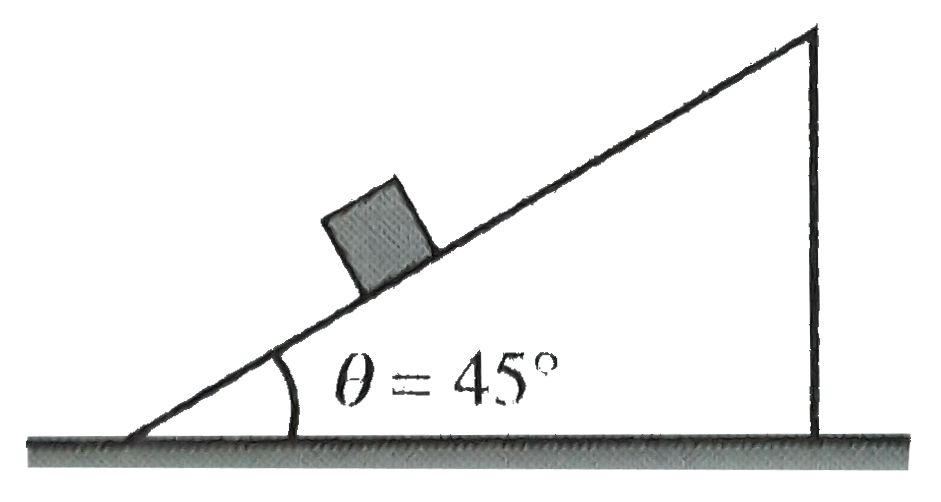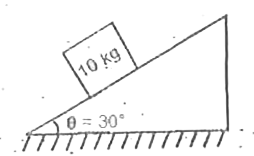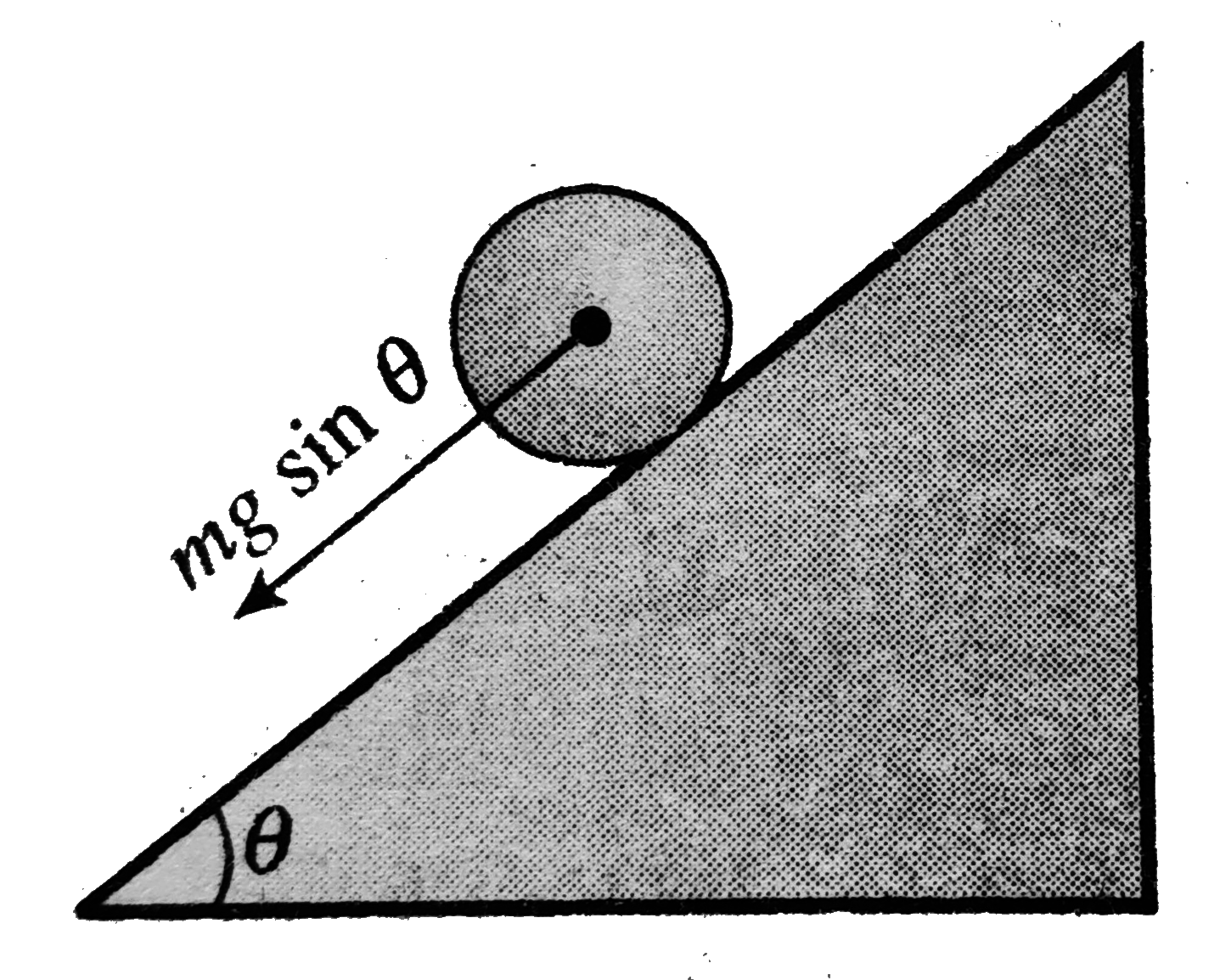A body of mass 2 kg is lyign on rough inclined plane of inclination 300. Find the mgnitude of the force parallel to the incline needed to make tkheblock move a. up the incline b. down the incline. Coefficient of static friction =0.2
To solve the problem, we need to find the forces acting on a block of mass 2 kg lying on a rough inclined plane with an angle of inclination of 30∘ and a coefficient of static friction of 0.2. We will calculate the force required to move the block both up and down the incline.
1. Identify the Forces Acting on the Block:
- The weight of the block (W) acts vertically downward and is given by:
W=mg=2kg×9.8m/s2=19.6N
- The weight can be resolved into two components:
- Perpendicular to the incline: W⊥=mgcosθ
- Parallel to the incline: W∥=mgsinθ
2. Calculate the Components of Weight:
- For θ=30∘:
W⊥=mgcos(30∘)=19.6N×√32=16.97N
W∥=mgsin(30∘)=19.6N×12=9.8N
3. Calculate the Frictional Force:
- The maximum static frictional force (Ff) is given by:
Ff=μs×W⊥=0.2×16.97N=3.394N
4. Force Required to Move the Block Up the Incline:
- To move the block up the incline, the applied force (F) must overcome both the gravitational component down the incline and the frictional force acting down the incline:
F=W∥+Ff=9.8N+3.394N=13.194N
5. Force Required to Move the Block Down the Incline:
- To move the block down the incline, the applied force must overcome the gravitational component down the incline minus the frictional force acting up the incline:
F′=W∥−Ff=9.8N−3.394N=6.406N
Final Answers:
- The force required to move the block up the incline is approximately 13.2 N.
- The force required to move the block down the incline is approximately 6.4 N.
- The weight of the block (W) acts vertically downward and is given by:
W=mg=2kg×9.8m/s2=19.6N
- The weight can be resolved into two components:
- Perpendicular to the incline: W⊥=mgcosθ
- Parallel to the incline: W∥=mgsinθ
- For θ=30∘:
W⊥=mgcos(30∘)=19.6N×√32=16.97N
W∥=mgsin(30∘)=19.6N×12=9.8N
- The maximum static frictional force (Ff) is given by:
Ff=μs×W⊥=0.2×16.97N=3.394N
- To move the block up the incline, the applied force (F) must overcome both the gravitational component down the incline and the frictional force acting down the incline:
F=W∥+Ff=9.8N+3.394N=13.194N
- To move the block down the incline, the applied force must overcome the gravitational component down the incline minus the frictional force acting up the incline:
F′=W∥−Ff=9.8N−3.394N=6.406N
- The force required to move the block up the incline is approximately 13.2 N.
- The force required to move the block down the incline is approximately 6.4 N.
Topper's Solved these Questions
- BOOK - HC VERMA ENGLISHCHAPTER - FRICTIONEXERCISE - Questions for short Answer11videos
FRICTION
- BOOK - HC VERMA ENGLISHCHAPTER - FRICTIONEXERCISE - Objective -25videos
FRICTION
- BOOK - HC VERMA ENGLISHCHAPTER - FLUID MECHANICSEXERCISE - All Questions90videos
FLUID MECHANICS
- BOOK - HC VERMA ENGLISHCHAPTER - GRAVITATIONEXERCISE - Question for short Answers18videos
GRAVITATION
Similar Questions
A body of mass 2 kg is lying on rough inclined plane of inclination 30 degree . Find the magnitude of the force parallel to the incline needed to make the block move a. up the incline b. down the incline. Coefficient of static friction =0.2
Repeat part a. of problem 6 if the push is applied horizontally and not parallel to the incline.View SolutionA block of mass m=3kg slides on a rough inclined plane of cofficient of friction 0.2 Find the resultant force offered by the plane on the block
 View Solution
View Solution
Knowledge Check
- Question 1 - Select One
A body of mass 100 g is sliding from an inclined plane of inclination 30∘. What is the frictional force experienced if μ=1.7 ?
A1.7×√2×(1/√3)NB1.7×√3×(1/2)NC1.7×√3 ND1.7×√2×(1/3) N
A block of mass 2.0 kg is pushed down an inclined plane of inclination 370 with a force of 20N acting parallel to the incline. It is found that the block moves on the incline with an acceleration of 10ms2. If the block started from rest, find the work done a. by the applied force in the first second b. by the weight of the block in the first second and c. by the frictional force acting on the block in the first second. Take g=10ms2.
View SolutionA block of mass 2.0 kg is pushed down an inclined plane of inclination 370 with a force of 20N cting parallelto the incline. It is found tht the block moves on the incline with an acceleration of 10ms2. If the blcok started from rest, find the work done a. by the applied force in the first second b. by the weight of the block in the first second and c. by the frictional force acting on the block in the first second. Take g=10ms2.
View SolutionA block of mass 5.0 kg slides down an incline of inclination 300 and length 10 m. find the work done by the force of gravity.
View SolutionA block of mass 10 kg is kept on a fixed rough (μ=0.8) inclined plane of angle of inclination 30∘. The frictional force acting on the block is
 View Solution
View SolutionA block of mass m moves with constant speed down the inclined plane of inclination θ. Find the coefficient of kinetic friction.
 View Solution
View SolutionA solid cylinder of mass 3kg is placed on a rough inclined plane of inclination 30∘. If g=10ms2, then the minimum frictional force required for it to roll without slipping down the plane is
 View Solution
View SolutionA body of mass m is kept on a rough fixed inclined plane of angle of inclination θ=30∘. It remains stationary. Then magnitude of force acting on the body by the inclined plane is equal to :
View Solution

